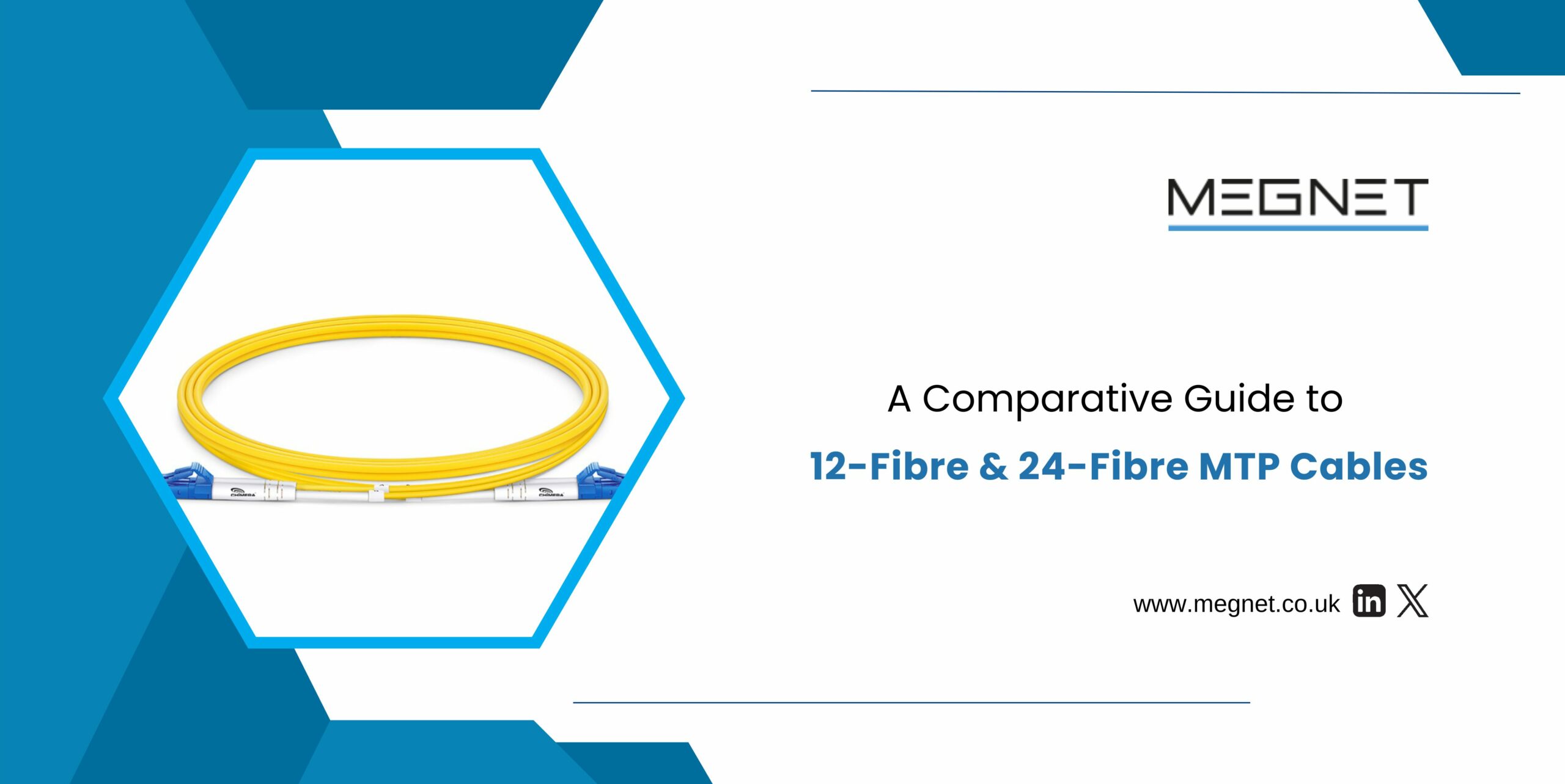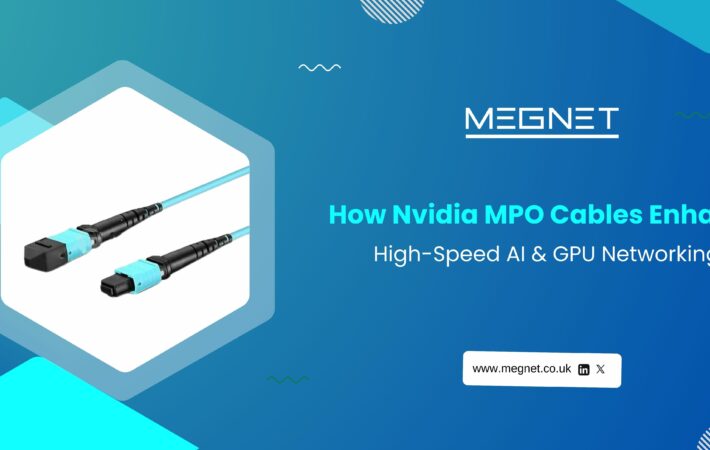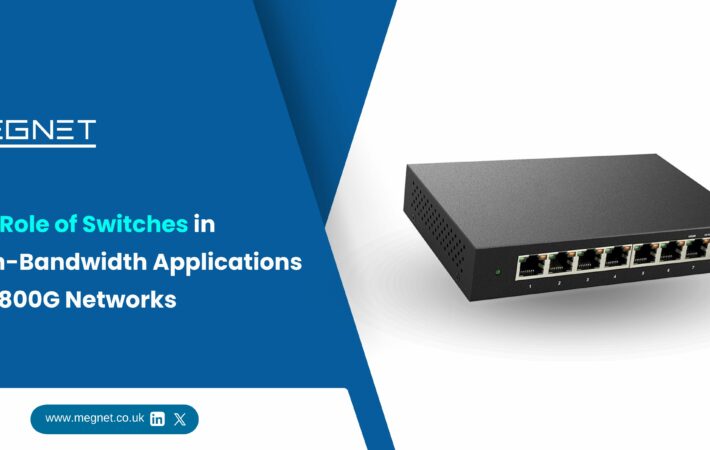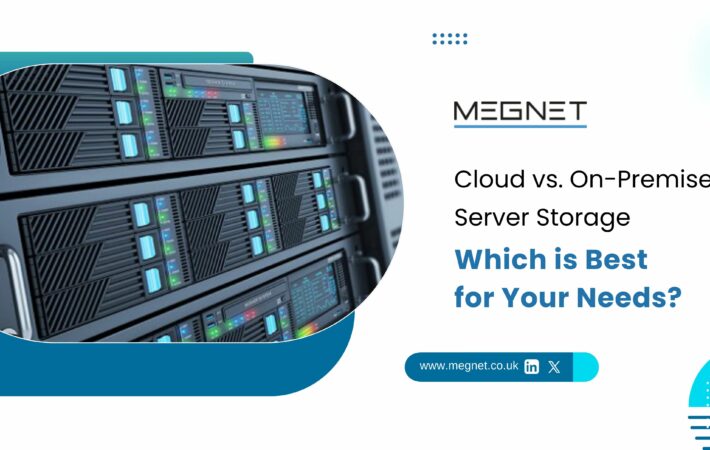
Introduction to MTP Cables and Their Growing Importance in Modern Networking
As organizations expand, so do their data needs. From fast-growing enterprises to data centres handling vast amounts of information, network infrastructure has become a critical investment. At the heart of high-speed data transmission lies a crucial component: the Multi-Fibre Termination Push-on (MTP) cable. MTP cables, which come in various fibre counts such as 12-fibre and 24-fibre, have revolutionized the way businesses manage high-density networking. But how do you decide which MTP cable is best for your network?
In this guide, we’ll explore the differences, benefits, and practical applications of 12-fibre and 24-fibre MTP cables to help you make an informed choice.
Understanding 12-Fibre MTP Cables
Key Specifications of 12-Fibre MTP Cables
The 12-fibre MTP cable is widely used in network setups that handle moderate data traffic. It’s designed to support 10G and 40G applications, making it ideal for businesses and data centres with average bandwidth requirements. With its compact design, this cable type is also compatible with QSFP (Quad Small Form-Factor Pluggable) modules, often used in local area networks (LANs) and enterprise environments.
Benefits of 12-Fibre MTP Cables
One of the primary benefits of 12-fibre MTP cables is their flexibility. They are easier to install, manage, and scale as the business grows. Additionally, the 12-fibre count means less cable congestion, making it simpler for technicians to handle and maintain. This cable type is also more cost-effective than its higher-density counterparts, which is beneficial for businesses on a budget.
For instance, a small-to-medium-sized business aiming to improve its internal network’s efficiency may find the 12-fibre MTP cable a perfect match. It offers the right balance between performance and affordability.
Exploring 24-Fibre MTP Cables
Key Specifications of 24-Fibre MTP Cables
The 24-fibre MTP cable, on the other hand, caters to high-bandwidth applications. Supporting up to 100G and even 400G, this cable type is a top choice for data centres and large-scale enterprises with demanding data needs. It’s compatible with high-speed modules and is engineered to support massive data flow without interruptions, making it ideal for future-proofing high-density networks.
Benefits of 24-Fibre MTP Cables
The primary advantage of 24-fibre MTP cables is their superior density. With twice the fibre count of the 12-fibre option, these cables can support more data traffic, which translates to more efficient utilization of space and resources. This higher density can also reduce the cost per fibre, which makes it a valuable investment for organizations looking to scale up rapidly.
For example, a large data centre that processes significant data loads for its clients would benefit from the high-capacity and space-saving nature of 24-fibre MTP cables.
Key Differences Between 12-Fibre and 24-Fibre MTP Cables
- Bandwidth and Speed Considerations: One of the key differences between 12-fibre and 24-fibre MTP cables is the bandwidth they support. While a 12-fibre cable can handle 10G to 40G applications, the 24-fibre variant is designed to support higher-speed applications up to 400G.
- Think of the two as lanes on a highway: the 12-fibre MTP cable provides a two-lane path for data, while the 24-fibre option opens up a four-lane expressway, allowing for faster and more efficient data traffic flow.
- Cost and Investment Analysis: Cost is another major factor to consider. While 12-fibre MTP cables are more affordable upfront, the higher density and increased capacity of 24-fibre cables can lead to savings in terms of cost per fibre, especially in high-volume setups. However, for smaller organizations, the 12-fibre cable may offer sufficient bandwidth without the added cost of higher-density infrastructure.
- Space and Cable Management Requirements: Although 24-fibre MTP cables offer higher density, they come with added complexity. These cables can contribute to denser cable layouts, which may require more careful management. Smaller setups may prefer the simplicity of 12-fibre MTP cables, while larger enterprises with advanced cabling systems may find 24-fibre cables more advantageous.
Choosing the Right MTP Cable for Your Network Needs
Assessing Your Network’s Current and Future Needs
Before making a decision, it’s essential to evaluate your network’s current bandwidth requirements as well as future growth. A “network health check-up” is recommended, where you assess not only today’s needs but also how your business or data centre plans to evolve.
Budget and Scalability: Making the Right Investment
A common mistake is to choose solely based on current costs without considering scalability. Think of this decision as a smart investment that can save costs on potential upgrades and compatibility issues down the line. For rapidly growing companies, a higher upfront investment in 24-fibre MTP cables could provide significant long-term savings by eliminating the need for frequent upgrades.
Long-Term Maintenance and Upgrades
When considering maintenance, keep in mind that higher-density cables might require more effort and planning. A well-planned choice today could help reduce maintenance costs and downtime in the future, allowing for easy scalability as your network grows.
Practical Use Cases of 12-Fibre and 24-Fibre MTP Cables
Real-World Applications of 12-Fibre MTP Cables
A medium-sized office with expanding data needs may find 12-fibre MTP cables to be the ideal solution. These cables can support the growing demands of a typical enterprise without overwhelming the network. As the company’s network requirements increase, the 12-fibre MTP infrastructure can provide reliable performance.
Real-World Applications of 24-Fibre MTP Cables
On the other hand, a data centre that processes massive data loads for various clients would benefit from the increased capacity of 24-fibre MTP cables. The ability to handle higher speeds and denser data streams without compromising performance makes these cables an ideal choice for large-scale, high-density networking environments.
While the simplicity and cost-effectiveness of 12-fibre MTP cables are well-known, they also offer other advantages:
- Flexibility in Deployment: These cables can be easily repurposed for different applications within small to medium-sized networks. For instance, a company upgrading its backbone can use existing 12-fibre MTP cables for edge devices or less demanding connections, maximizing ROI.
- Compatibility with Legacy Systems: For businesses transitioning from older network architectures, 12-fibre MTP cables offer seamless compatibility with legacy systems, reducing downtime during upgrades.
Deeper Insights into 24-Fibre MTP Cables
Optimized for Parallel Optics
24-fibre MTP cables are inherently optimized for parallel optics, enabling multiple lanes of data to be transmitted simultaneously. This is particularly critical for data centres leveraging 100G and 400G connections.
Energy Efficiency and Sustainability
While not always highlighted, the reduced cabling footprint of 24-fibre cables also translates into improved airflow and cooling efficiency in data centres. By minimizing the number of cables required, 24-fibre solutions contribute to lower energy consumption—a growing priority in green IT initiatives.
What Happens When You Overlook the Right MTP Cable?
Selecting the wrong MTP cable for your network can lead to costly mistakes:
- Performance Bottlenecks: Using a 12-fibre cable in a high-bandwidth environment like video streaming can lead to delays, buffering, or downtime, directly impacting user satisfaction.
- Excessive Costs: Choosing 24-fibre cables for low-traffic networks may seem like future-proofing, but the unused capacity can translate into unnecessary upfront costs.
- Operational Challenges: A mismatch in capacity and application can create operational inefficiencies, requiring frequent upgrades or additional cabling to meet demand.
Solution: Always consult a networking expert before making decisions to ensure your infrastructure aligns with your needs.
Market Trends Driving MTP Cable Adoption
- Rise of AI and Machine Learning: AI-powered applications generate massive data volumes, necessitating high-bandwidth, low-latency infrastructure. MTP cables, particularly 24-fibre variants, ensure these systems function seamlessly.
- 5G Network Expansion: The rollout of 5G networks relies on high-density fibre optics for backhaul and edge connectivity. MTP cables are pivotal in meeting these requirements, especially in densely populated urban areas.
- Global Data Centre Growth: The data centre market is projected to grow exponentially, driven by cloud services and IoT devices. Both 12-fibre and 24-fibre MTP cables are central to scaling these infrastructures efficiently.
- Increased Focus on Energy Efficiency: As enterprises aim to reduce carbon footprints, the compact design of 24-fibre MTP cables plays a critical role in achieving sustainability goals without compromising performance.
Future Technologies and MTP Cables
800G Ethernet and Beyond
The networking industry is already preparing for 800G Ethernet, and 24-fibre MTP cables are poised to lead the charge. These cables provide the capacity required for such advancements without major infrastructure overhauls.
Data Centres and Hyperscale Growth
With hyperscale data centres becoming the norm, the scalability of 24-fibre MTP cables is a critical factor. These cables can handle the massive interconnectivity required by facilities supporting services like AI processing and real-time analytics.
Smart Cities and IoT
MTP cables are not just for data centres anymore. As cities adopt smart technologies, these cables are playing a role in connecting everything from traffic systems to public safety networks.
Expanding on Choosing the Right Cable: Key Considerations
Industry-Specific Needs
Different industries have unique networking requirements. Here’s how 12-fibre and 24-fibre cables cater to various sectors:
- Healthcare: Hospitals with digital imaging and telemedicine platforms require high-speed data transfer, making 24-fibre cables the better option.
- Retail: Smaller retail chains benefit from 12-fibre cables for connecting their point-of-sale systems, ensuring reliable performance at a lower cost.
- Education: Universities with multiple campuses often require 24-fibre cables to handle inter-campus data transfers efficiently.
Cable Management Challenges
Improper cable management can negate the benefits of either cable type. For instance, a high-density rack poorly optimized for 24-fibre cables may suffer from airflow issues, negating the space savings and energy efficiency.
MTP Cables in Action: Real-World Scenarios
To truly appreciate the versatility of 12-fibre and 24-fibre MTP cables, let’s explore some real-world use cases:
- Enterprise Data Centres
In enterprise environments, scalability and efficiency are paramount. For example, a global financial institution may utilize 24-fibre MTP cables for its primary data centre to support high-speed interconnects between servers, storage devices, and switches. Meanwhile, 12-fibre cables can be deployed for branch offices or edge computing setups, where bandwidth requirements are comparatively lower.
- High-Performance Computing (HPC)
Scientific research facilities often rely on HPC clusters for data-intensive tasks like genome sequencing or weather modeling. These setups demand ultra-low latency and high bandwidth, making 24-fibre MTP cables indispensable.
- Broadcasting and Media Production
Broadcast studios handling 4K/8K video streams require robust connections for real-time editing and transmission. Here, 12-fibre MTP cables are sufficient for individual workflows, while 24-fibre cables connect multiple workflows to centralized storage and rendering servers.
- Educational Campuses
Universities deploying smart classroom technologies, virtual labs, and e-learning platforms need flexible network designs. Using a combination of 12-fibre cables for individual buildings and 24-fibre cables for campus-wide interconnectivity ensures cost-efficiency and future-proofing.
Myths vs. Facts: MTP Cable Misconceptions
Myth 1: Higher Fibre Count Always Means Better Performance
Fact: Performance depends on the application. For a low-latency application like trading, the quality of connectors and the design of the network matter more than the fibre count.
Myth 2: MTP Cables Are Only for Data Centres
Fact: MTP cables are increasingly being adopted in industrial automation, smart grids, and healthcare sectors where robust and scalable connections are critical.
Myth 3: Upgrading from 12-Fibre to 24-Fibre Requires a Complete Overhaul
Fact: Modular systems and hybrid adapters allow for seamless integration without disrupting existing networks.
Key Innovations in MTP Technology
The evolution of MTP cables continues to surprise with innovations aimed at enhancing performance and usability.
- Low-Loss MTP Connectors: Advanced connectors reduce signal loss, ensuring longer transmission distances even with high-density cabling.
- Field-Installable Connectors: These simplify installations in remote or challenging environments, reducing deployment time and costs.
- Color-Coded Fibres: Simplifying cable identification and troubleshooting, especially in environments with dense cabling systems.
- Temperature-Resilient Cables: Designed for harsh environments, these MTP cables can function efficiently in extreme conditions, such as industrial sites or outdoor telecom installations.
Future-Proofing Your Network with MTP Cables
With rapid advancements in networking technologies, the choice of MTP cables today directly impacts the scalability and relevance of your infrastructure tomorrow.
- Modular Cabling Solutions
Investing in modular patch panels that support both 12-fibre and 24-fibre MTP cables ensures adaptability as your network requirements grow.
- Planning for 800G and Beyond
The 400G Ethernet standard is already pushing network capabilities, and 800G is just around the corner. Deploying 24-fibre MTP cables prepares your network for these advancements without the need for frequent upgrades.
- Integration with AI and Edge Computing
As AI and edge computing proliferate, networks need to handle data at lightning speeds with minimal latency. MTP cables are central to ensuring these next-gen architectures perform optimally.
How MTP Cables Support Multi-Tenant Environments
Multi-tenant environments, such as colocation data centres, present unique challenges for network infrastructure. These facilities host equipment for multiple clients, each with specific bandwidth and scalability needs. MTP cables, especially 24-fibre variants, offer:
- High Density Without Overcrowding: They allow colocation providers to maximize fibre connections within limited rack space.
- Effortless Tenant Scaling: As clients require additional bandwidth, 24-fibre cables can accommodate growth without needing entirely new cabling systems.
- Tenant Isolation: Segregating client networks using dedicated fibres ensures security and eliminates risks of data crossover.
Advanced Applications of MTP Cables
- 5G Backhaul Networks
MTP cables play a pivotal role in the high-speed backhaul connections required for 5G infrastructure. The high density and low latency of 24-fibre MTP cables ensure seamless communication between cell towers and core networks, enabling faster data transmission and supporting real-time applications like augmented reality (AR) and autonomous vehicles.
- High-Speed Trading
In financial services, where microseconds matter, MTP cables enable direct, low-latency connections between trading platforms and servers. Firms often use 12-fibre cables for specific trading desks and 24-fibre cables for backbone connectivity.
- Media Streaming Services
Streaming giants like Netflix or YouTube rely on robust fibre optic networks to deliver high-definition content to millions of users worldwide. 24-fibre cables are integral to these operations, enabling quick transmission of large video files to content delivery networks (CDNs).
Customization Options for MTP Cables
MTP cables are highly customizable to meet diverse networking needs:
- Fibre Type: Choose between single-mode or multimode fibres based on the distance and speed requirements of your network.
- Polarity: MTP cables come in multiple polarity configurations (A, B, and C), ensuring compatibility with various setups.
- Connector Gender: Select between male (pins) and female (no pins) connectors, depending on the type of patch panels and equipment used.
- Cable Jacket Material: For outdoor deployments, cables with ruggedized jackets are available to withstand extreme conditions.
Cost-Benefit Analysis: 12-Fibre vs. 24-Fibre MTP Cables
To assist decision-making, let’s break down the cost-benefit of these cables:

Troubleshooting Common Issues with MTP Cables
Even the most robust networks encounter challenges. Here are some common MTP cable issues and solutions:
- Signal Degradation
- Cause: Dirty connectors or excessive bend radius.
- Solution: Regular cleaning of connectors and adhering to bend radius guidelines.
- Incompatible Polarity
- Cause: Misalignment between patch panels and equipment.
- Solution: Verify polarity during the installation phase. Utilize polarity testers to ensure correct alignment.
- Excessive Insertion Loss
- Cause: Subpar connectors or mismatched cables.
- Solution: Invest in high-quality MTP cables and conduct thorough testing after installation.
- Overcrowding in Racks
- Cause: Poor cable management.
- Solution: Use cable trays and labeling systems to organize fibres effectively.
The Role of MTP Cables in Edge Computing
With the rise of edge computing, where data is processed closer to its source, MTP cables have become more relevant than ever:
- Reducing Latency: 24-fibre cables provide the high-speed, high-capacity connections required for real-time data processing in edge environments.
- Compact Solutions: Edge data centres often have space constraints, making the density and efficiency of MTP cables invaluable.
- Future-Ready for IoT: As IoT devices proliferate, the ability of MTP cables to handle increasing data volumes ensures seamless connectivity.
Best Practices for MTP Cable Deployment
To maximize the benefits of MTP cables, follow these best practices:
- Plan for Growth: Always design your network with at least a 3-5 year growth trajectory in mind.
- Use MPO Testing Tools: Invest in MPO testers to verify insertion loss, polarity, and continuity before deployment.
- Optimize for Airflow: Avoid overpacking cables to maintain adequate airflow, reducing the risk of overheating.
- Label Everything: Proper labeling simplifies maintenance and reduces troubleshooting time.
- Train Your Team: Ensure your installation and maintenance teams are trained in handling MTP cabling systems to avoid errors.
Global Market Trends for MTP Cables
The demand for MTP cables is influenced by global networking trends. Here’s how the market is shaping up:
- Increased Adoption of 5G: The rollout of 5G networks has spurred demand for MTP cables, especially in telecom networks requiring high-speed backhauls.
- Data Centre Expansion in Emerging Markets: Countries in Asia, the Middle East, and Africa are experiencing a boom in data centre construction, creating significant demand for high-density cabling solutions.
- Government Investments in Smart Cities: Initiatives to develop smart cities have increased the use of fibre optics, with MTP cables playing a vital role in connecting IoT devices and sensors.
- Growth of Remote Work: The shift to remote work has increased demand for robust networking infrastructures, pushing organizations to upgrade with scalable solutions like MTP cables.
Future Innovations in MTP Technology
- As networking technology evolves, so do MTP cables. Let’s explore the future developments that promise to redefine their capabilities:
- AI-Driven Network Monitoring : MTP cables integrated with AI-based monitoring systems can self-diagnose issues like signal degradation or connector contamination. Real-time alerts can enable proactive maintenance, reducing downtime.
- Eco-Friendly Fibre Solutions : With sustainability becoming a key focus, manufacturers are developing MTP cables with recyclable materials and reduced carbon footprints. These cables align with the green initiatives many organizations are adopting.
- Higher Fibre Counts : While 12-fibre and 24-fibre configurations are currently the standards, there’s ongoing research into 48-fibre and even 72-fibre MTP cables. These higher-density options will be essential for future applications like 1.6 Tbps Ethernet.
- Enhanced Compatibility with Emerging Technologies : As quantum computing and terabit networking become more mainstream, MTP cables are being designed to meet the extreme data rate and bandwidth demands of these technologies.
Top Questions to Ask Before Investing in MTP Cables
Before making your purchase, ask these critical questions to align your choice with your organization’s needs:
- What Are My Network’s Bandwidth Projections for the Next 5 Years?
This helps determine whether 12-fibre or 24-fibre MTP cables are a better fit. - What Is the Maximum Distance My Network Needs to Cover?
Single-mode cables are ideal for long distances, while multimode cables suffice for shorter spans. - How Important Is Scalability?
If your network is expected to grow rapidly, investing in higher fibre counts or modular systems is advisable. - What Testing Equipment and Expertise Do I Need?
Ensure your team is equipped with the necessary tools and skills for installation and maintenance. - Are My Existing Patch Panels Compatible?
Verify compatibility to avoid additional expenses in replacing supporting infrastructure.
Why Choose Megnet for Your MTP Cable Needs?
At Megnet, we understand the critical role that cabling plays in modern networks. Here’s why organizations worldwide trust us for their MTP solutions:
- Extensive Range: From 12-fibre to 24-fibre configurations, we offer products tailored to every application.
- Global Reach: With strategically located warehouses, we deliver quickly and efficiently, no matter where your business operates.
- Unmatched Quality: All our cables meet or exceed industry standards, ensuring peak performance and reliability.
- Lifetime Warranty: We stand behind our products with a lifetime warranty, offering you peace of mind.
- Expert Support: Our team of seasoned professionals is available to assist you in selecting the right cables and ensuring a seamless installation.
FAQ's
12-fibre MTP cables have 12 fibres, ideal for moderate-bandwidth applications. 24-fibre MTP cables, on the other hand, offer twice the fibre density, making them suitable for high-bandwidth and large-scale networks.
Choose 12-fibre MTP cables for smaller or less demanding networks with lower bandwidth requirements or limited space.
Higher fibre counts like 24-fibre cables provide greater scalability, allowing networks to expand without replacing cables. They support more connections, reducing future upgrade costs.
12-fibre MTP cables can work for smaller data centers or those with less stringent bandwidth needs. However, 24-fibre cables are better for larger, high-demand environments.
Yes, you can mix both, but it's essential to ensure proper compatibility with connectors, patch panels, and equipment for seamless performance.
24-fibre MTP cables are ideal for applications like 5G backhaul, large-scale data centers, cloud services, and high-speed trading where high bandwidth and low latency are critical.
12-fibre MTP cables, typically multimode, support distances of up to 300 meters for 10G speeds and can extend further with single-mode configurations.
Yes, 24-fibre MTP cables can be configured for either multimode or single-mode fibre depending on your network's distance and bandwidth requirements.
While both types are relatively easy to install, 24-fibre MTP cables may take slightly more time due to their higher fibre density, but the difference is minimal when using proper tools and techniques.








Leave a comment
Your email address will not be published. Required fields are marked *